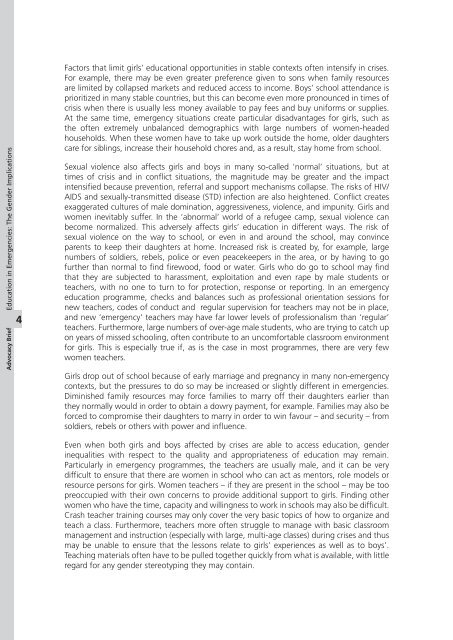Education in Emergencies: The Gender Implications - INEE
Education in Emergencies: The Gender Implications - INEE
Education in Emergencies: The Gender Implications - INEE
- No tags were found...
You also want an ePaper? Increase the reach of your titles
YUMPU automatically turns print PDFs into web optimized ePapers that Google loves.
Advocacy Brief <strong>Education</strong> <strong>in</strong> <strong>Emergencies</strong>: <strong>The</strong> <strong>Gender</strong> <strong>Implications</strong>Factors that limit girls’ educational opportunities <strong>in</strong> stable contexts often <strong>in</strong>tensify <strong>in</strong> crises.For example, there may be even greater preference given to sons when family resourcesare limited by collapsed markets and reduced access to <strong>in</strong>come. Boys’ school attendance isprioritized <strong>in</strong> many stable countries, but this can become even more pronounced <strong>in</strong> times ofcrisis when there is usually less money available to pay fees and buy uniforms or supplies.At the same time, emergency situations create particular disadvantages for girls, such asthe often extremely unbalanced demographics with large numbers of women-headedhouseholds. When these women have to take up work outside the home, older daughterscare for sibl<strong>in</strong>gs, <strong>in</strong>crease their household chores and, as a result, stay home from school.Sexual violence also affects girls and boys <strong>in</strong> many so-called ‘normal’ situations, but attimes of crisis and <strong>in</strong> conflict situations, the magnitude may be greater and the impact<strong>in</strong>tensified because prevention, referral and support mechanisms collapse. <strong>The</strong> risks of HIV/AIDS and sexually-transmitted disease (STD) <strong>in</strong>fection are also heightened. Conflict createsexaggerated cultures of male dom<strong>in</strong>ation, aggressiveness, violence, and impunity. Girls andwomen <strong>in</strong>evitably suffer. In the ‘abnormal’ world of a refugee camp, sexual violence canbecome normalized. This adversely affects girls’ education <strong>in</strong> different ways. <strong>The</strong> risk ofsexual violence on the way to school, or even <strong>in</strong> and around the school, may conv<strong>in</strong>ceparents to keep their daughters at home. Increased risk is created by, for example, largenumbers of soldiers, rebels, police or even peacekeepers <strong>in</strong> the area, or by hav<strong>in</strong>g to gofurther than normal to f<strong>in</strong>d firewood, food or water. Girls who do go to school may f<strong>in</strong>dthat they are subjected to harassment, exploitation and even rape by male students orteachers, with no one to turn to for protection, response or report<strong>in</strong>g. In an emergencyeducation programme, checks and balances such as professional orientation sessions fornew teachers, codes of conduct and regular supervision for teachers may not be <strong>in</strong> place,and new ‘emergency’ teachers may have far lower levels of professionalism than ‘regular’teachers. Furthermore, large numbers of over-age male students, who are try<strong>in</strong>g to catch upon years of missed school<strong>in</strong>g, often contribute to an uncomfortable classroom environmentfor girls. This is especially true if, as is the case <strong>in</strong> most programmes, there are very fewwomen teachers.Girls drop out of school because of early marriage and pregnancy <strong>in</strong> many non-emergencycontexts, but the pressures to do so may be <strong>in</strong>creased or slightly different <strong>in</strong> emergencies.Dim<strong>in</strong>ished family resources may force families to marry off their daughters earlier thanthey normally would <strong>in</strong> order to obta<strong>in</strong> a dowry payment, for example. Families may also beforced to compromise their daughters to marry <strong>in</strong> order to w<strong>in</strong> favour – and security – fromsoldiers, rebels or others with power and <strong>in</strong>fluence.Even when both girls and boys affected by crises are able to access education, gender<strong>in</strong>equalities with respect to the quality and appropriateness of education may rema<strong>in</strong>.Particularly <strong>in</strong> emergency programmes, the teachers are usually male, and it can be verydifficult to ensure that there are women <strong>in</strong> school who can act as mentors, role models orresource persons for girls. Women teachers – if they are present <strong>in</strong> the school – may be toopreoccupied with their own concerns to provide additional support to girls. F<strong>in</strong>d<strong>in</strong>g otherwomen who have the time, capacity and will<strong>in</strong>gness to work <strong>in</strong> schools may also be difficult.Crash teacher tra<strong>in</strong><strong>in</strong>g courses may only cover the very basic topics of how to organize andteach a class. Furthermore, teachers more often struggle to manage with basic classroommanagement and <strong>in</strong>struction (especially with large, multi-age classes) dur<strong>in</strong>g crises and thusmay be unable to ensure that the lessons relate to girls’ experiences as well as to boys’.Teach<strong>in</strong>g materials often have to be pulled together quickly from what is available, with littleregard for any gender stereotyp<strong>in</strong>g they may conta<strong>in</strong>.
















